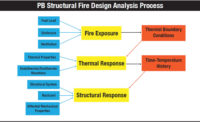The International Code Council has approved—as expected—the updated structural building-design standard, written by the American Society of Civil Engineers Structural Engineering Institute, for inclusion in the 2018 edition of the ICC’s model International Building Code. ICC’s validation committee certified “ASCE/SEI 7-16: Minimum Design Loads and Associated Criteria for Buildings and Other Structures,” and ICC’s board of directors confirmed it late last month, says Mike Pfeiffer, ICC’s senior vice president, technical services.
The National Association of Home Builders and a few other groups had opposed the inclusion of the updated reference standard because of new provisions related to seismic loads; tsunami-resistant design for critical buildings; and increases in low- and flat-roof wind-pressure coefficient, mostly along the southeastern seaboard and Gulf Coast.
Tsunami-resistant design is a new subject for ASCE 7 (ENR 10/10/16 p.8). Another new subject for the 2016 update, scheduled for publication in June, is performance-based structural fire engineering (PBSFE).
Chapter One, Section 1.3.7, on fire resistance, with Appendix E: “Performance-Based Design Procedures for Fire Effects on Structures,” closes a gap in the ASCE standard, says Kevin J. LaMalva, chair of the ASCE/SEI fire-protection committee. “This is the first time fire effects are considered as an explicit design load in a U.S. engineering standard,” adds LaMalva, a senior staff consultant at Simpson Gumpertz & Heger Inc.
In 2011, the SEI technical activities division “identified the lack of relevant guidance for structural fire engineering as an industry dilemma and tasked our committee to develop the guidance,” says LaMalva, who co-authored the standard with Therese P. McAllister, community resilience group leader at the National Institute of Standards and Technology.
Section 1.3.7 offers performance-based fire engineering as an alternative to the traditional prescriptive methods of design. “The performance-based design procedures in Appendix E are permitted where approved by the authority having jurisdiction,” says the standard.
The appendix is not a mandatory part of the ASCE standard. Rather, it provides procedures for PB design and evaluation of structures for fire conditions that result in fire-induced effects on a structure’s members and connections, says the appendix. The appendix does not provide for standard fire-resistance design using prescriptive methods. It also does not address explosions.
The appendix lays out the following PBSFE tasks: identify performance objectives; quantify the fuel load; identify and evaluate structural design fires; determine temperature histories of structural members and connections, and determine the response of the structure.
Structural response “shall be evaluated against limit states based on the performance objectives,” says the appendix. “The analyses shall account for temperature-dependent material properties, boundary conditions and thermally induced failure modes and shall evaluate structural stability, strength, deformation and load path continuity.”
Appendix E gives requirements for structural fire engineering but does not give guidance as to how to fulfill the requirements. Toward that end, ASCE will publish, likely by the end of the year, a manual of practice for structural fire engineering. “This will be the first of its kind,” says LaMalva, who is the editor of the document, which is about 100 pages.
The appendix and the manual are “steps toward legitimizing structural fire engineering as a discipline within structural engineering,” adds LaMalva.




Post a comment to this article
Report Abusive Comment